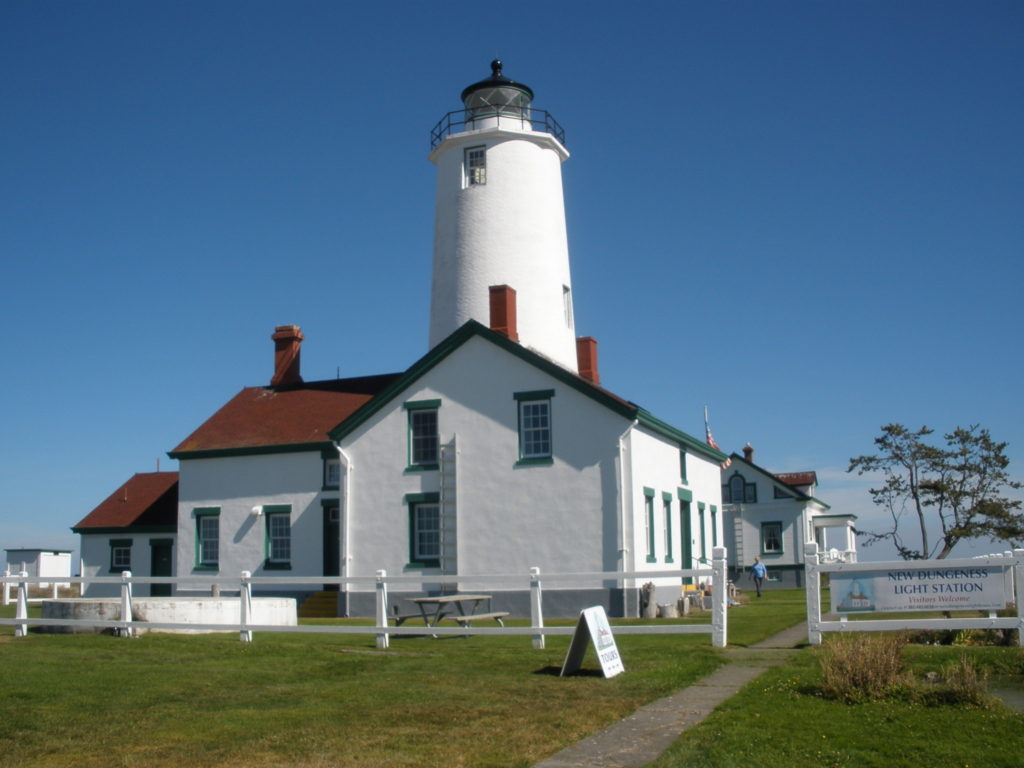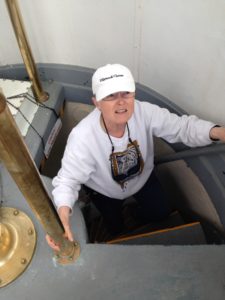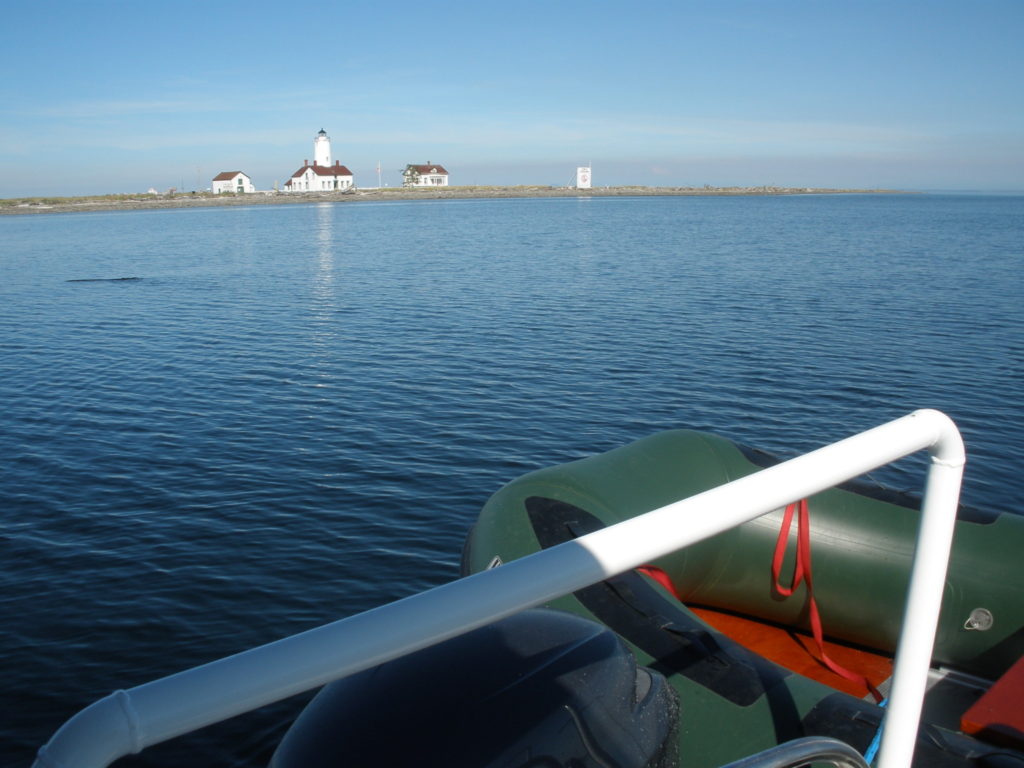Sequim Treasures: The New Dungeness Lighthouse

November 9, 2016
By Dorothy Rice Bennett
Everybody loves lighthouses, right? I know I do. I’ve traveled the coast of Maine, up and down the California coastline, and followed Highway 101 through Oregon and Washington, always with the hope of finding another lighthouse. They are not only beautiful historic structures—they light up the coastline, and lighthouses suggest something positive, hopeful, and enlightened.
Not every coastal city or town has its own lighthouse. Sequim is one of the lucky ones. New Dungeness Lighthouse sits near the end of the Dungeness Spit north of the city proper. It is reachable by boat and by a rather long walk—more than five miles each way—along the Dungeness Spit from the Dungeness National Wildlife Refuge.
That particular spit of land was reputedly the first soil on which early sailors set foot as they explored what is today the Strait of Juan de Fuca and the Puget Sound. The lighthouse was opened in 1957; it stands sixty-three feet high and is still an active navigational aid.
Getting there
I’ve been fortunate to visit the New Dungeness Lighthouse by boat. Captain Charles Martin keeps a twenty-six-foot power catamaran, Livin’ the Dream, at the John Wayne Marina in Sequim and takes small groups of tourists on various water adventures. One available trip is to our lighthouse. My journey required passage through Sequim Bay to its mouth and then across Dungeness Bay toward the spit. There is no dock at the lighthouse, so our group transferred from the powerboat to a smaller inflatable that could go ashore to let us off and pick us up again. The lighthouse can also be reached by small power craft and kayaks from Cline Spit in Dungeness Bay.
Water travel to the lighthouse is admittedly very dependent on weather. Wind, high tides and waves can cause trip cancellations. Walking to the lighthouse can also be a challenge. At high tide, the spit is largely under water; therefore, the hike must be planned to start and finish within acceptable tide levels to avoid stepping on rocks and climbing over tree trunks. Starting times, resting periods at the lighthouse during low tide, and the return walk must be planned carefully.
Volunteer lighthouse keepers
Exploring this lighthouse is delightful fun. Outside, there are picnic tables, restrooms, green lawn, and a drinking fountain to help make hikers and boating visitors comfortable. Inside, there are tour guides available. They are called, quite logically, “Lighthouse Keepers.”
The keepers live in an adjoining building (modern inside with TV and WiFi) and spend a few hours daily maintaining the lighthouse and surrounding areas as well as providing tours. Keepers sign up to serve for a week and sometimes wait up to a year to get a slot. It’s not free—they pay for the privilege of staying at the lighthouse, but the cost for a week is about the same as a motel room would be. They cook for themselves, read, play table games, take hikes, watch TV, keep up with their Facebook pages—and enjoy the incredible serenity of the lighthouse grounds.
 Tours of the museum and tower are available from 9 to 5 daily. Climbing the seventy-four steps to the top of the tower was a bit of a challenge for me but offered a marvelous view of the Dungeness Refuge, the Straits, and Canada. Outside, at ground level, I was impressed by the absence of noise. I cannot imagine a more peaceful setting!
Tours of the museum and tower are available from 9 to 5 daily. Climbing the seventy-four steps to the top of the tower was a bit of a challenge for me but offered a marvelous view of the Dungeness Refuge, the Straits, and Canada. Outside, at ground level, I was impressed by the absence of noise. I cannot imagine a more peaceful setting!
Two of the keepers during my visit were from Indianapolis in my home state of Indiana (I grew up in Speedway, home of the Indy 500) A married couple, the two had planned for a long time for their special week. Very friendly, they compared notes with me about the lighthouse and “back home in Indiana.” The Hoosiers raved about the wonderful air quality at the lighthouse and the quiet that they totally enjoyed.
The small museum on the bottom floor includes a Fresnel lamp, history of the lighthouse, displays about the Native Americans who have lived in this area, and of course, brochures about the lighthouse association. Very few souvenirs are available but can be purchased online (I got myself a lighthouse T-shirt, for example).
Back again
I loved being at the lighthouse so much that on a second visit by boat, I took with me friends that I knew would have a good time. While the weather can interfere, the climate on the Olympic Peninsula is relatively mild and the lighthouse provides a possible day-trip during most of the year.
If you are a real lighthouse aficionado, there are more day-trip lighthouses close to this area: Point Wilson Light at Fort Worden State Park near Port Townsend; Admiralty Head Lighthouse on Whidbey Island; Point No Point Light at Hansville near Kingston; and Cape Flattery Lighthouse on Tatoosh Island, visible from the far end of Cape Flattery Trail at Neah Bay on the Olympic Peninsula.
For current details about the New Dungeness Lighthouse, I suggest you go to the website http://newdungenesslighthouse.com For information on boat tours to the lighthouse, check out http://thewaterlimousine.com
Happy lighthouse exploring!


Comments
Sequim Treasures: The New Dungeness Lighthouse — No Comments
HTML tags allowed in your comment: <a href="" title=""> <abbr title=""> <acronym title=""> <b> <blockquote cite=""> <cite> <code> <del datetime=""> <em> <i> <q cite=""> <s> <strike> <strong>